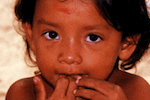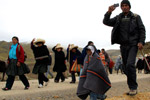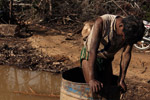In the summer of 2009, on a highway in Peru known as Devil’s Curve: everything went wrong. For months, indigenous groups had protested new laws by then President Alan Garcia opening up the Amazon to deregulated logging, fossil fuels, and other extractive industries as a part of free trade agreements with the U.S. But the protests came to a bloody head on June 5th when police clashed with activists, leaving at least 32 dead and 200 injured. Now—five years later—53 indigenous activists are on trial for the massacre, including many facing life in prison.
Among those on trial are Alberto Pizango, the president of indigenous rights NGO, Interethnic Association for the Development of the Peruvian Rainforest (AIDESEP).
“If the case should move forward with charges that carry in some cases a life sentence, the future of Peru will hang in the balance,” said Pizango’s lawyer Marco Barreto after today’s oral arguments. “Are we a democracy that protects all of its citizens under the law? Are we to return to the days of the Spanish colonizers, serving up our precious resources to benefit only those who have power and wealth, while destroying our environment and the culture of the peoples that help define our nation?”

Aerial view of Peruvian Amazon. Photo by: Rhett A. Butler.
Six other indigenous leaders are also on trial. With 53 activists, many of them well-known and facing between 35 years to life in prison,
the trial has been dubbed the biggest in Peruvian history. Some of those charged were faraway in their local communities at the time of the massacre.
The violence that day, which occurred just outside the oil-town of Bagua, followed a state of emergency proclaimed by the government in early May. In response, indigenous activists set up blockades on several roads including Devil’s Curve. When police attempted to tear down the blockade, violence ensued ending with 22 dead police officers and 10 civilians. But some have disputed those numbers, claiming police burned and hid bodies of protesters.
Weeks after the bloody melee, the country’s congress threw out the two controversial decree that set off the protests.
“It is tragically ironic that the hosts of a major climate summit are criminalizing people who tried to save the Amazon from destruction,” said Andrew Simms of Global Witness, referring to Peru hosting the United Nations Climate Change Conference in December. In fact, Pizango recently met with government officials about the role of indigenous people at the summit.
“Tropical forests are a key line of defense against global warming, and are worth more in every sense standing than they are cut down,” Simms added. “People who put themselves on the line to prevent deforestation should certainly not be stripped of their rights, their land and thrown in jail.”
Related articles
New report reveals human rights abuses by corporations, governments in the Amazon

(05/14/2014) Regnskogfondet (the Rainforest Foundation of Norway) recently released a 52-page report that gives an in-depth account of the conflicts activists and indigenous peoples (IPs) are having with corporations and governmental agencies. It relays a situation that does not look good.
Legal logging concessions drive illegal logging in Peru, threatening forests and indigenous people

(04/17/2014) Nearly 70 percent of officially inspected logging concessions in Peru have had their permits canceled or are under investigation for major breaches of forestry laws, finds a new study published in the journal Scientific Reports. Worryingly, the research also concludes that forestry permits are being widely used to launder timber illegally logged from outside concession areas.
Photos: Weird aquatic lizard discovered in mountain streams of Peru
(03/13/2014) A ‘new’ species of lizard has been described from the cloud forests of Peru’s Manu National Park, reports SERNANP, the Peruvian National Park Service.
The price of gold: winners and losers in Latin America’s mining industry

(03/05/2014) On a Friday afternoon in June, the Plaza de Armas in Cajamarca is pulsing with life. It’s winter here, and although thick white clouds hover low in the distance, the sun in this northern Peruvian city is warm. Couples sit on benches facing one another. Kids run in the grass between flowerbeds. Men in suits stride along the perimeter. It’s an idyllic day. But signs of something more ominous are not far from sight. On the mountainside overlooking the town the words Nova Conga have been carved into the vegetation. It is a constant reminder that beyond the square, hemmed with international hotels and expensive restaurants, there is another reality.
The making of Amazon Gold: once more unto the breach

(02/19/2014) When Sarah duPont first visited the Peruvian Amazon rainforest in the summer of 1999, it was a different place than it is today. Oceans of green, tranquil forest, met the eye at every turn. At dawn, her brain struggled to comprehend the onslaught of morning calls and duets of the nearly 600 species of birds resounding under the canopy. Today, the director of the new award-winning film, Amazon Gold, reports that “roads have been built and people have arrived. It has become a new wild west, a place without law. People driven by poverty and the desire for a better life have come, exploiting the sacred ground.”
Helping the Amazon’s ‘Jaguar People’ protect their culture and traditional wisdom

(02/11/2014) Tribes in the Amazon are increasingly exposed to the outside world by choice or circumstance. The fallout of outside contact has rarely been anything less than catastrophic, resulting in untold extinction of hundreds of tribes over the centuries. For ones that survived the devastation of introduced disease and conquest, the process of acculturation transformed once proud cultures into fragmented remnants, their self-sufficiency and social cohesion stripped away, left to struggle in a new world marked by poverty and external dependence
Gas company to drill in Manu National Park buffer zone, imperiling indigenous people
(02/04/2014) The Peruvian government has approved plans for gas company Pluspetrol to move deeper into a supposedly protected reserve for indigenous peoples and the buffer zone of the Manu National Park in the Amazon rainforest. The approval follows the government rescinding a highly critical report on the potential impacts of the operations by the Culture Ministry (MINCU), the resignation of the Culture Minister and other Ministry personnel, and repeated criticism from Peruvian and international civil society.
287 amphibian and reptile species in Peruvian park sets world record (photos)

(01/28/2014) It’s official: Manu National Park in Peru has the highest diversity of reptiles and amphibians in the world. Surveys of the park, which extends from high Andean cloud forests down into the tropical rainforest of the Western Amazon, and its buffer zone turned up 155 amphibian and 132 reptile species, 16 more than the 271 species documented in Ecuador’s Yasuní National Park in 2010.
Red toad discovered in the upper reaches of the Amazon
(01/19/2014) Scientists have described a previously unknown species of toad in the Peruvian Andes.
Environmental groups: top secret Pacific trade agreement to sacrifice wildlife, environment
(01/16/2014) Environmental groups have blasted draft text of the Trans-Pacific Partnership (TPP) released yesterday by WikiLeaks as potentially devastating to the environment and wildlife. The massive 12-nation free trade agreement has been negotiated in secret now for almost four years, and the information release by WikiLeaks shows that key environmental safeguards in the agreement are being stripped away, including a ban on shark finning and illegal logging, as well as legally-enforced pollution regulations.